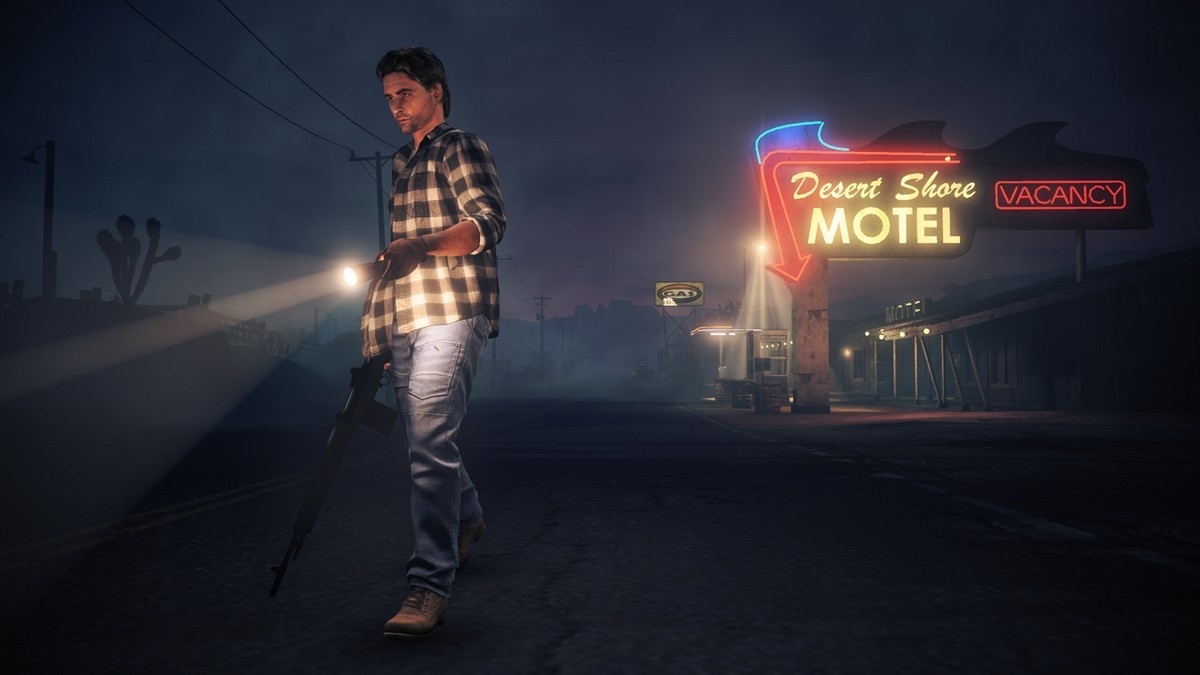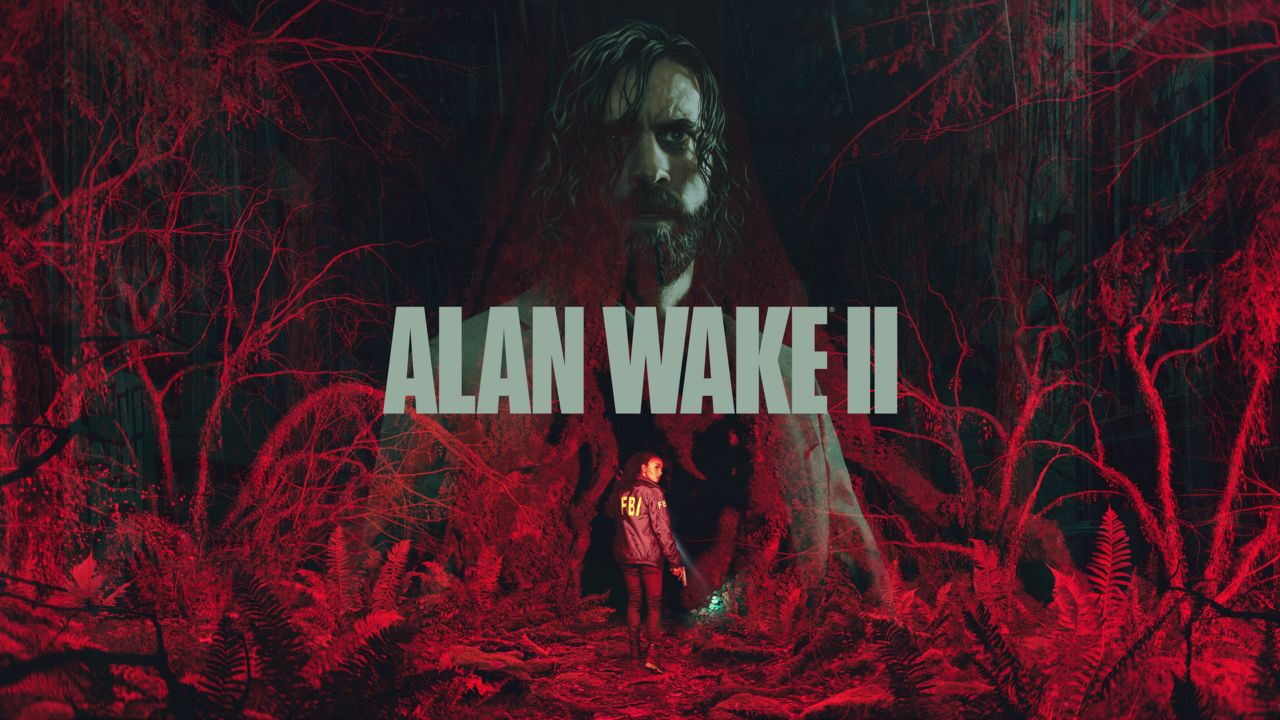A sequel to Alan Wake once seemed impossible, with the original game launching in 2010 and becoming the sort of cult classic that is fondly remembered by fans but typically not expanded upon in an industry obsessed with mega-hits. However, after 13 years, one quasi-sequel, and one DLC tie-in, Remedy is finally returning to its well of inky darkness and releasing the sequel, Alan Wake 2, which shifts into full-on survival-horror, introduces a second playable character, and continues to build on the Remedy Connected Universe’s elaborate lore. Whether you simply want a refresher of what’s happened already, you need a complete introduction to the world of Alan Wake, or you just want to see how your favorite fan theories are doing before you dive into the sequel, here’s everything that’s happened in the Alan Wake story so far.
The story of Alan Wake kicks off in the Pacific Northwest in 2010, in the ominously named Bright Falls, Washington, a logging- and mining-oriented town that harbors a dark secret. For Alan and his wife Alice, however, it’s meant to be a safe haven for the ever-disgruntled and writer’s-blocked Alan to rest his head and take some time away from the hustle and bustle of New York City and his life as a bestselling crime author.
Alan and Alice arrive at their secluded Bird Leg Cabin which sits by its lonesome atop Cauldron Lake. Though the views are incredible, things take a turn for the worse on the first night of their stay. The hot-headed Alan storms out of the cabin in a huff when he discovers Alice brought a typewriter with the hope that Alan might find more success writing given his change of scenery. Rather rudely, he leaves his nyctophobic (that means “afraid of the dark”) wife alone in the creepy cabin during a power outage, and immediately lives to regret it, as Alice is attacked by a Dark Presence just seconds later. Alan rushes in but manages only to witness her be pulled into the infinite darkness of Cauldron Lake. Suddenly feeling heroic, he jumps in after her.
The next thing he knows, Alan awakens from behind the wheel of a crashed car. Alone in the woods of Bright Falls other than a strange apparition clad in a diving suit that acts as Alan’s part-time guiding light–don’t worry, we’ll get back to this–Alan soon discovers he’s missing a week of time. To make matters worse, he starts to find pages of a manuscript he supposedly wrote, and the events described on the pages begin coming to life. That would be fine if the author were writing about getting a good night’s sleep or eating cake, but Alan’s not so lucky. His story is a horror story, and soon axe-wielding maniacs, possessed construction trucks, and Hitchcockian birds all have it out for him.
Eventually he catches his breath and gets the attention of Sheriff Sarah Breaker, who delivers the bad news that Bird Leg Cabin hasn’t existed for decades and it was destroyed by a volcanic eruption, leaving Alan’s head hurting more than when he crashed his car.
Soon after, his loud-mouthed but endlessly faithful literary agent Barry Wheeler shows up in town to defend his client, as Alan’s gained the attention of local authorities, what with the whole crashing cars and misplacing wives routine. Alan spends the next several days in Bright Falls being pulled ceaselessly farther down a rabbit hole of Stephen King-like oddities. Though Breaker is cautiously helpful toward Alan, others are much less well-intentioned. The FBI shows up, led by an alcohol-abusing special agent named Nightingale, who seems to assume Alan’s guilt before he even crosses the town’s border. After relentlessly evading both him and the shadowy monsters shaped like townsfolk called the Taken, Alan meets up with a local who claims to have kidnapped his wife and is holding her for ransom. As it turns out, the self-proclaimed kidnapper is just a crony for Dr. Emil Hartman, a local therapist who specializes (or, more accurately, preys on) artists, such as painters, musicians, video game developers, and writers.
Either by temptation or corruption, Hartman seeks to utilize the Dark Presence for his own good, but just as he acted as the marionette to the kidnapper, it seems the Dark Presence was pulling his strings, too. Hartman is attacked in a supernatural assault on the mental health facility, and Alan barely makes it out alive.
Before he left the facility, Alan was able to get to know Tor and Odin Anderson, two old-timers from town who know a lot more than they were willing to let on in front of the doctor. The Anderson brothers direct Alan to their farm where they promise the writer some much-needed answers. There with Barry, Alan begins to understand the nature of the town’s monster. It appears the Dark Presence lurking in Bright Falls is empowered by art, and it manipulates artists to grow itself stronger through the worlds they imbue with purpose, like a song by the Andersons under their moniker The Old Gods of Asgard, or a story, like that written by Alan during his missing week, during which time the Dark Presence served as something like his evil editor. By doing this, the Dark Presence is able to grow its influence beyond its domain known as the Dark Place, a subjective supernatural realm that can appear different to different people, but is never the type of place one would want to land in.
Alan seeks out the “lady of the light,” a spot-on callback to Twin Peaks’ Log Lady, who understands better than anyone in town what exactly is going on. If it’s not yet weird enough for you, here’s where things really start to unravel. The lady of the light, Cynthia Weaver, explains to Alan that she’s seen what is happening before–back in the 1970s when it was a poet named Thomas Zane who was manipulated by the Dark Presence. In that case, the darkness kidnapped and eventually took on the appearance of his lover, Barbara Jagger. Zane stumbled his way to a conclusion that perhaps could have rescued Jagger and instead lost her for good. Now it’s Alan’s turn to try and save his love from the same cruel fate.
The ghostly diver Alan has been seeing turns out to be Zane, who has been trying to guide Alan to a happier ending than he got himself. To that end, Weaver explains to Alan that Zane left behind a shoebox specifically for Alan to find years later. In it rests “the clicker,” a portion of a broken light switch Alan used to play with as a child. To Alan and players alike, the reveal becomes a headache-inducing timeloop. How did Zane write into reality this clicker that comes from Alan’s time as a kid, or did he not at all do that? Did Alan write Zane into existence? It’s the story’s best chicken-and-egg scenario in a basket full of fan theories and lingering mysteries, and not to get too far ahead, but fans are still trying to make sense of it today.
However the clicker got there, Alan comes to understand his purpose. He must correct Zane’s wrongs, which led to his partner’s demise, in order to save Alice. Alan takes the clicker and, after a long march through hell, finally comes face to face with the Dark Presence, once more wearing Jagger’s likeness. Alan understands that a horror story requires sacrifice and balance. The writer can’t create the happy ending they may want. It doesn’t make narrative sense, and that allows the strangely art-obsessed Dark Presence to prey on those who get greedy, as Alan feels Zane did back in the ’70s.
To improve on Zane’s unintentionally tragic conclusion, Alan writes a new ending to the story. He thrusts the clicker into the black heart of Barbara Jagger and turns it on, sending a burst of magical light scorching through the monster. She is defeated, but not entirely. Instead, it’s enough to create an opening for Alice to escape the Dark Presence. She emerges from the depths of Cauldron Lake and swims to shore shaken but otherwise seemingly okay despite having spent over a week in the Dark Place. Alan then makes his much-needed sacrifice, submitting himself to the Dark Place in place of Alice. In doing so, Zane informs Alan that a doppelganger, whose name can’t be heard over a scratching sound that is formed when Zane says it–thus earning him the name Mr. Scratch–will take Alan’s place while Alan is away from the physical world from which he came. Alan then sits down and prepares to write his exit in a story titled “Return.”
The original game ends this way, though through two DLC chapters we see Alan growing stronger and becoming more familiar with the Dark Place. He can manipulate the world using words more intricately than before, bringing objects into existence that may aid him as he tries to escape the Dark Place. The mainline game ends with Alan still stuck there, though players would get to explore it more in 2012 with the game’s pseudo-sequel, Alan Wake’s American Nightmare.
In American Nightmare, the theme of timeloops returns, this time to tell a story of Alan further exploring the Dark Place, now presented as the fictional southwestern-looking town of Night Springs, which shares a name with the in-universe Twilight Zone-like TV series. All the while, Alan’s doppelganger, Mr. Scratch, seems to wreak havoc in the real world. Alan’s disappearance from his normal life and the surrounding events of Bright Falls have given birth to urban legends of a writer, Alan, who snapped and started killing people during a vacation with his wife. These rumors manifest as Mr. Scratch, who is basically Alan’s evil twin that becomes a real-life serial killer.
Throughout a series of looping events orchestrated by Mr. Scratch to keep Alan imprisoned forever in the Dark Place, Alan is aided by a trio of women, none of whom are Alice–or even anyone familiar to players–taking up residence at a motel, a theater, and an observatory. Each woman holds a different part of the solution to defeating Mr. Scratch, but the problem is they each keep dying or Alan otherwise fails in his attempts to gather all he needs. His task is to create the perfect loop and save all of them so that they can survive long enough to help him too.

The story takes several weird turns–even for this series–including a crashed satellite that blows up an oil derrick in the desert. However, after several spins through the timeloop, Alan is able to keep all three women alive and collect everything he needs to defeat Mr. Scratch. The twins have their showdown at the movie theater where it’s revealed that Alan’s secret weapon was a movie Alice made that writes Mr. Scratch out of existence. It works, and Alan and Alice share a loving embrace at the end of the game. However, a narrator’s voice calls into question whether the events of American Nightmare really happened or if they were just Alan’s tortured daydreams while he remains stuck in the Dark Place. And in case you’re wondering, Remedy does consider this game canon to the overarching story.
That was all the Alan Wake story we were served for nearly a decade. Then, in 2020, Remedy’s latest game at that time, Control, confirmed the speculation that Control and Alan Wake shared a universe in a DLC chapter called AWE, even elaborating with quite a lot of new material. Collectively, players now know these games and others yet to come as the Remedy Connected Universe. The name AWE officially refers to the idea of an Altered World Event, a term for the wild stuff that happens around the country that is then investigated by the Federal Bureau of Control (FBC), which is like if Scully and Mulder’s X-Files division had proper funding. However, fans have reasonably joked that AWE also means “Alan Wake Expansion,” since that’s effectively what this DLC was.
In AWE, we learn a lot about the current state of things in the modern Remedy Connected Universe as it pertains to Alan Wake. For one, we learn that the events of Bright Falls, including Alan’s saga, Zane’s saga, and at least one more unspecified event that predates either of those, have been classified as Altered World Events. Some in-game hints seemed to also suggest Alan may have birthed the FBC itself through his abilities to alter reality through writing, though a summer 2023 chat with Remedy’s Sam Lake clarified for us that this is not the case. We also learn that Alan is still missing in the present day, and that Alice is haunted by nightmarish images of her long-lost love. It’s assumed by many that the wicked person she is seeing is actually Mr. Scratch and that he was not truly defeated in the events of American Nightmare.
We also learn that the FBC investigated Dr. Hartman’s activities surrounding Cauldron Lake’s special properties. Obsessed with understanding and harnessing the lake’s powers, Hartman eventually dove into the lake himself but was consumed by the darkness much like Barbara Jagger and others were, which led to him being imprisoned within The Oldest House, the shape-shifting physical–but also metaphysical–headquarters for the FBC.
As the entity, Hartman broke free, which led the FBC to retreat and seal up the wing of The Oldest House that stored much of the Bright Falls investigation materials. During the events of Control, when the supernatural Hiss took over the building, the two monstrous entities, the Dark Presence and the Hiss, merged within Hartman to create a third, worse thing. Jesse Faden, the playable character in Control, eventually defeats Hartman, if we can still call him that, and once and for all cleanses the investigations wing of its monster problem.

In Marvel-esque fashion, we then get a teaser for what’s to come. Computers within The Oldest House begin reporting on a new AWE occurring in Bright Falls, only it’s oddly set to the future–a meta nod to the fact that Alan Wake 2 was still a few years off.
All of this brings us to the much-anticipated sequel. Alan’s world has moved on with time exactly as ours has, meaning it’s also 2023 during Alan Wake 2. Whether that’s true for Alan himself, who has spent the entire time locked in the Dark Place, desperate to create a new escape for himself, remains to be seen. Curiously, we haven’t seen much in the way of some of the original game’s major characters. Alan’s agent Barry, for example, has not been seen in any trailers, and his wife Alice has only come up in the Control DLC. We do know that agent Nightingale returns, but seems to be a now-deceased Taken entity with a body count of his own that brings FBI special agent Saga Anderson to the town of Bright Falls.
A brand-new character joining the series, Saga is a brilliant criminal profiler, and along with her partner, Alex Casey–who oddly bears the exact name and likeness as the protagonist in Alan’s crime novels–the pair will investigate Nightingale’s demise. But this will only lead the young G-woman down a dark path she couldn’t have foreseen.
We can expect other new characters, too, including a new FBC agent named Kieran Estevez and Sheriff Breaker’s cousin who will be portrayed by none other than Quantum Break’s Shawn Ashmore. Even Ahti, the janitor from Control who seems to hold more powers than just those a mop or broom might provide, will return prominently, ensuring the Remedy Connected Universe will continue to factor in heavily in this next game.
Players will experience the game through the eyes of both Alan and Saga in stories that run parallel and can be swapped out regularly at the player’s discretion. Players will get to piece together clues as Saga like a David Fincher character, while Alan will birth new realities with a story board in the Dark Place. Of course, the game’s fighting with light returns as each hero looks to shed the Taken of their sludgy shields before immobilizing them with more traditional methods, only now in a more survival-horror framework reminiscent of Resident Evil. Together, the pair will set out to unravel the mysteries of a murderous cult, rescue Alan from the Dark Place once and for all, and maybe live to tell their loved ones all about it.
Alan Wake 2 launches on Xbox Series X|S, PS5, and the Epic Games Store on October 27 and unlock times have recently been revealed. You won’t find it in physical storefronts, as it’s a digital exclusive. You can check out the Alan Wake 2 preorder offers and bonuses if you’re ready to dive into Cauldron Lake for yourself. For a lot more on the game, check out our many features and exclusive interviews.
The products discussed here were independently chosen by our editors.
GameSpot may get a share of the revenue if you buy anything featured on our site.
